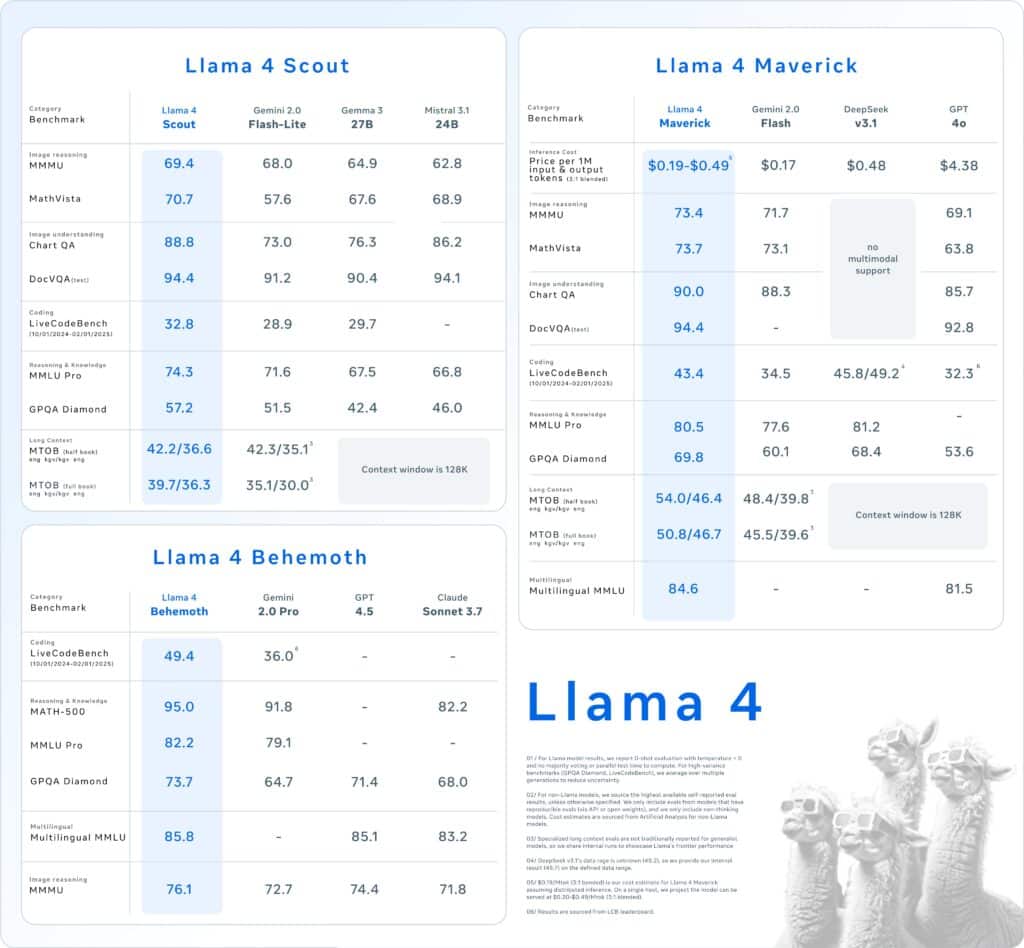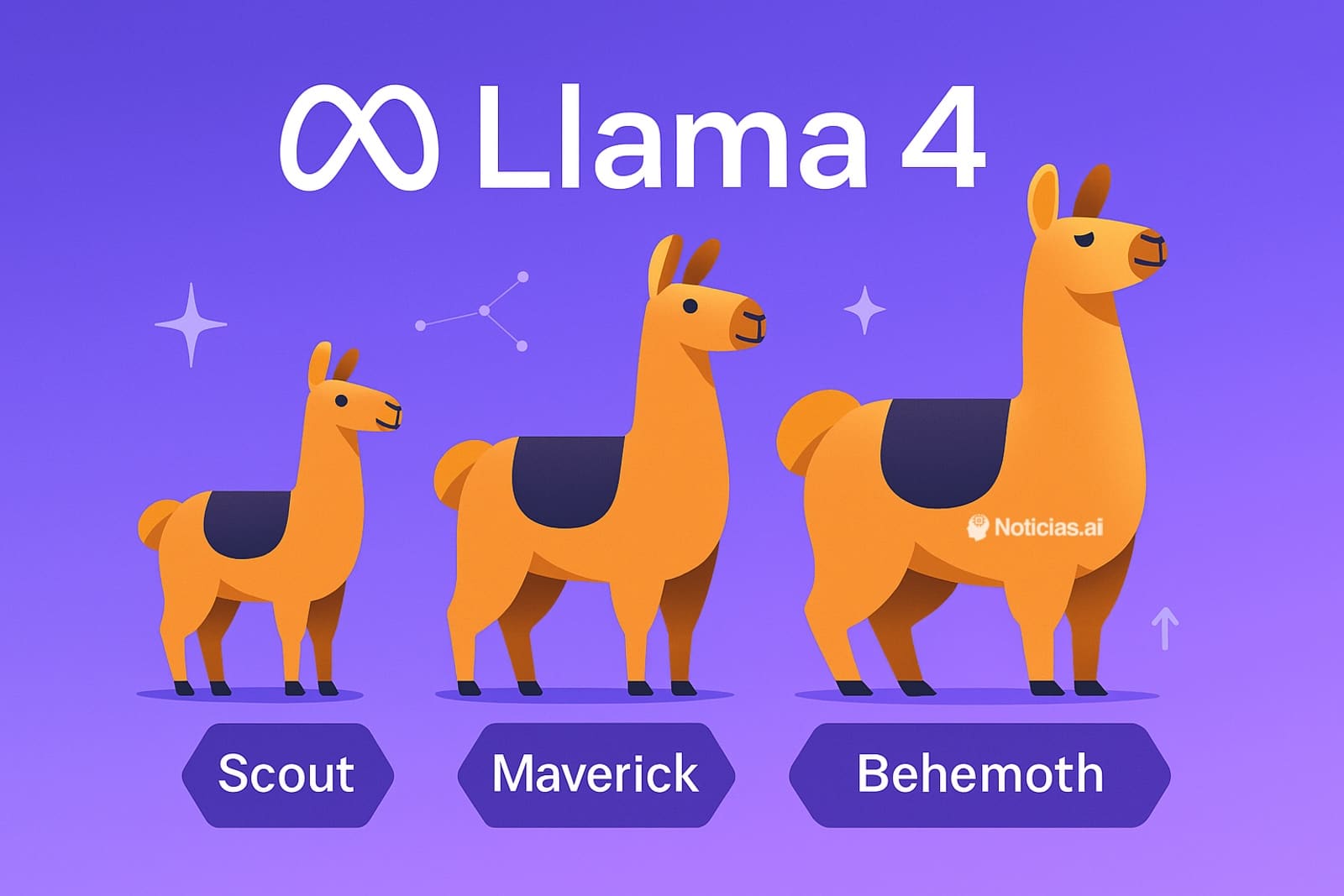Meta has taken a decisive step in the race to lead artificial intelligence with the launch of Llama 4, its most advanced model to date. This new version represents a complete overhaul of the Llama architecture and introduces three new models: Scout, Maverick, and Behemoth, designed to compete directly with the most powerful models on the market, such as OpenAI’s GPT-4o or Google’s Gemini 2.0.
With this new release, Meta is not only advancing technologically but also reaffirming its commitment to the open source model, allowing the global community to access and develop solutions based on these powerful systems.
Three Models for Different Needs
Llama 4 Scout, Maverick, and Behemoth represent three scales of capacity and performance, oriented toward different user profiles, from independent developers to large data centers:
- Llama 4 Scout: This is the lightest model (17 billion activated parameters), but it is no less powerful. It is designed to be extremely fast, efficient, and natively multimodal. It has a context window of over 10 million tokens and can run on a single GPU, making it an ideal option for local applications or resource-limited environments.
- Llama 4 Maverick: This is the model that strikes the best balance between performance and cost. It outperforms competitors such as GPT-4o and Gemini 2.0 Flash in various tests, achieving performance similar to DeepSeek 3.1 in reasoning and programming tasks, but with less than half the active parameters. Its conversational version has scored an ELO of 1,417 in benchmark tests, positioning it as a reference among open-source multimodal models.
- Llama 4 Behemoth: Currently in the training phase, it promises to be Meta’s most intelligent and advanced model. In its initial tests, it already surpasses models like GPT-4.5, Claude Sonnet 3.7, and Gemini 2.0 Pro in complex science, technology, and mathematics tasks. It is expected to set a new standard in the performance of frontier AI models.
Advanced Architecture and Multimodal Focus
One of the main innovations of Llama 4 is its complete adoption of the Mixture-of-Experts (MoE) architecture. This technology allows only the necessary blocks of the model to be activated based on the task, which optimizes performance and reduces resource consumption.
Additionally, the models have been trained from the ground up to be multimodal, meaning they can process text and images natively. This opens the door to richer and more contextual experiences in various fields: from conversational assistants to visual analysis systems or content generation.
A Clear Commitment to Open Source
Meta continues to bet on an open development model. Both Scout and Maverick are available under open source licenses, allowing developers, researchers, and companies to use, modify, and scale these models according to their needs. This approach aims to democratize access to artificial intelligence and foster innovation from the community.
The company has also received support from key platforms and partners such as Hugging Face, Together.ai, Databricks, Snowflake, and Ollama, ensuring rapid adoption and availability in multiple environments.
Comparison with Industry Giants
Meta positions its Llama 4 models as a clear alternative against AI giants. Initial comparisons show advantages in efficiency, cost, and performance compared to proprietary models such as GPT-4o and Gemini 2.0:
| Model | Multimodal | Context Tokens | Conversational ELO | Open Source | Hardware Requirements |
|---|---|---|---|---|---|
| Llama 4 Scout | Yes | >10M | — | Yes | 1 GPU |
| Llama 4 Maverick | Yes | — | 1,417 | Yes | 1 machine |
| Llama 4 Behemoth (preview) | Yes | — | — | Coming | High capacity |
| GPT-4o (OpenAI) | Yes | 128K | ~1,200 | No | High capacity |
| Gemini 2.0 Flash (Google) | Yes | 1M | — | No | High capacity |
What to Expect Next
Meta has hinted that this is not an isolated release. In the coming weeks, it will unveil new models focused on reasoning, as well as deeper integrations with its own platforms, including WhatsApp, Instagram, and Facebook. An expansion of capabilities toward video, voice, and autonomous tasks is also expected.
Llama 4 demonstrates that Meta is determined to be a key player in the development of advanced and open artificial intelligence. In the face of the advancement of proprietary and closed models, the company is betting on global collaboration and accessibility. This new generation of models not only raises the technological bar but also redefines what it means to build artificial intelligence as a community.

For more information and access to the model, visit llama.com. Free illustration from AI free images.

